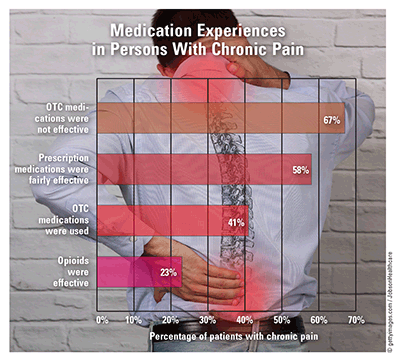US Pharm. 2018;43(3):41.
In 2006, according to the National Center for Health Statistics, 76.2 million Americans —one in every four—experienced pain that exceeded 24 hours, and millions more had acute pain. The CDC reported that, in 2016, 37.7% of adults never had pain, 42.8% had pain some days, 19.6% had pain most days or daily, and 50% to 75% of hospitalized patients in their last days of life died in moderate-to-severe pain. In a study, 20% of adults (42 million) reported that pain or physical discomfort disrupted their sleep at least a few nights per week, and 86% reported an inability to sleep well. Two-thirds of pain sufferers expected to live with some pain for the rest of their lives, whereas 30% expected to become pain-free from a cure or treatment.

Pain Occurrence: A higher percentage of previously employed adults (30.4%) had pain on most days, compared with never-employed (19.4%) and currently employed adults (15.1%). Compared with previously employed adults (30.7%), never-employed (42.0%) and currently employed adults (39.9%) were more likely to report never having had pain. Persons aged 45 to 64 years were most likely to report pain lasting >24 hours (30%), followed by adults aged 20 to 44 years (25%); individuals least likely to report pain were aged ≥65 years (21%).
Pain Sites: Most people with chronic pain had multiple pain sites. In 2012, >50% of adults (125 million) had a musculoskeletal pain disorder. Just over 20% of adults had arthritic conditions (22.1%) or lower back pain (20.3%). Smaller proportions of adults had nonarthritic joint pain or other joint conditions (17.5%), neck pain (14.3%), or sciatica (9.8%). A significant proportion had at least one other musculoskeletal problem that was not examined independently (28.1%). Nine of every 10 people who sought medical treatment for lower back pain were unable to determine the root cause. Adults with low back pain (28%) reported worse physical and mental health than those without low back pain (10%). More than 26 million adults aged 20 to 64 years experienced frequent back pain, and 17.7% missed work days because of it. Chronic low back pain was most prevalent among persons aged 45 to 54 years (26.7%), followed by those aged 55 to 64 (22.7%) and ≥65 years (21.7%).
Treatment: Pain treatments have yielded mixed results. Although 58% of persons who took prescription medication said that doing so was fairly effective for their pain, 67% of the 41% of patients who took OTC medications for chronic pain did not find them effective. Spine pain was the primary reason for seeking physical therapy, which was considered effective by 48% of pain sufferers.
To comment on this article, contact rdavidson@uspharmacist.com.






